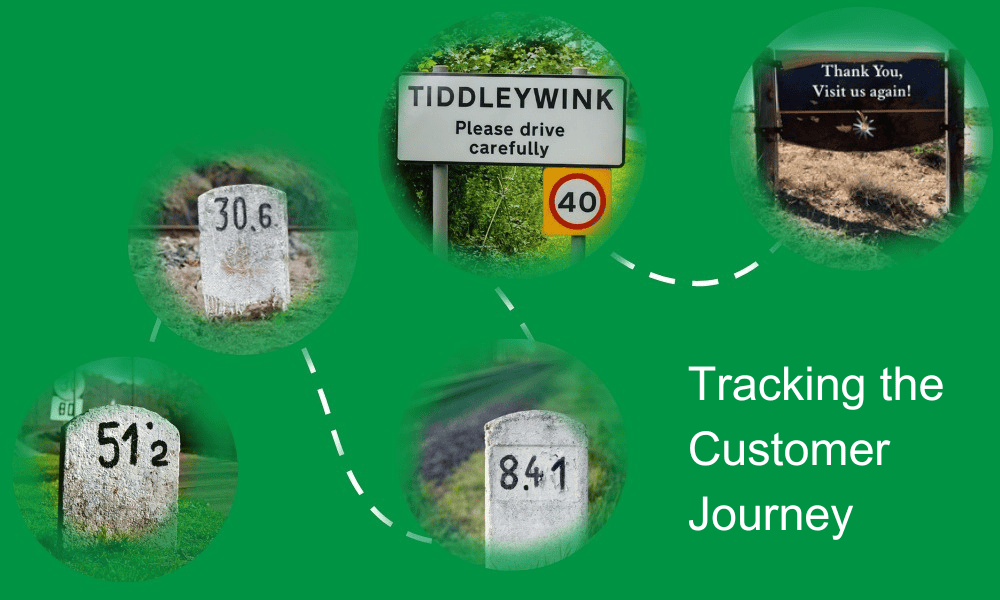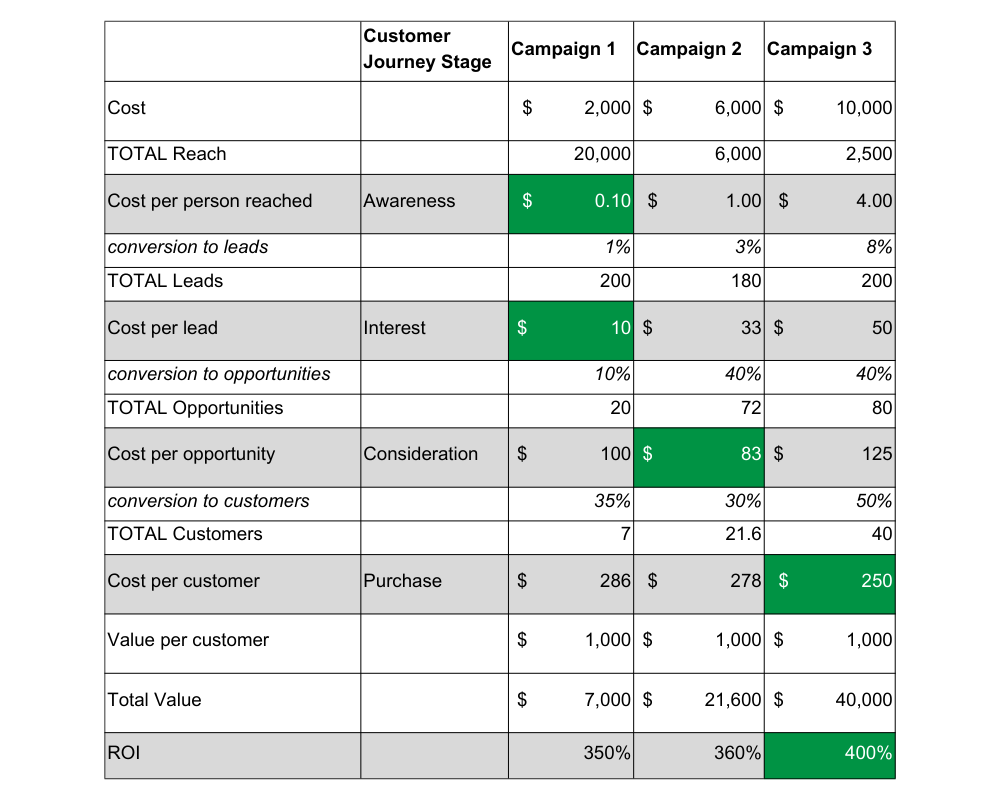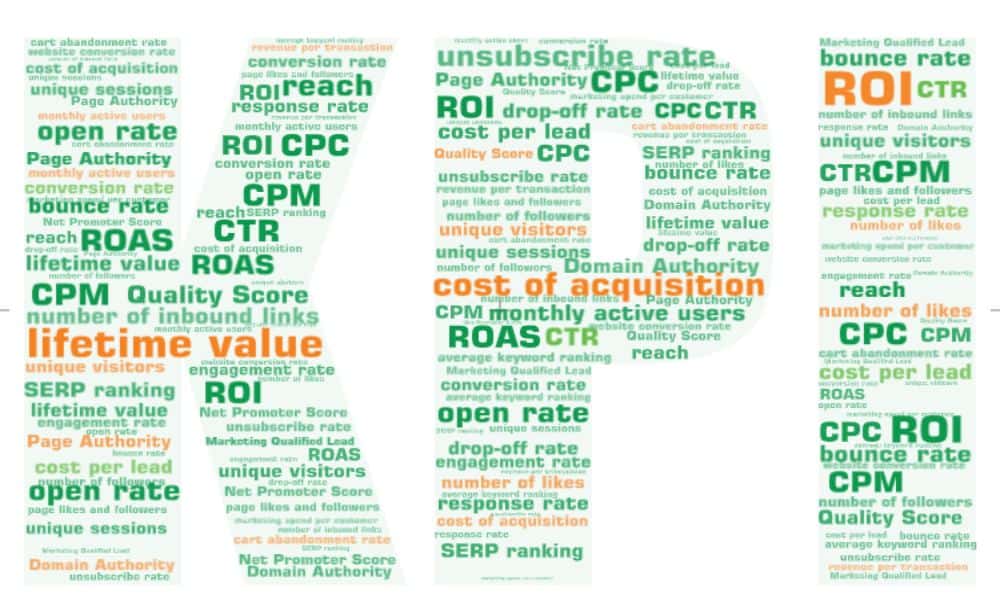Everyone in business hears plenty about KPIs. Most people in marketing hear about the customer journey. Today, I’m combining these two topics to explore customer journey KPIs. What they are and why they matter.
This may sound like a big topic for a simple copywriter, but remember, copywriting and content marketing are relevant across the entire customer journey.
Why you need customer journey KPIs
An earlier blog post explores the kinds of content people want at different stages of the customer journey up to the point of purchase.
You may not have time to read it now, so here’s the summary.
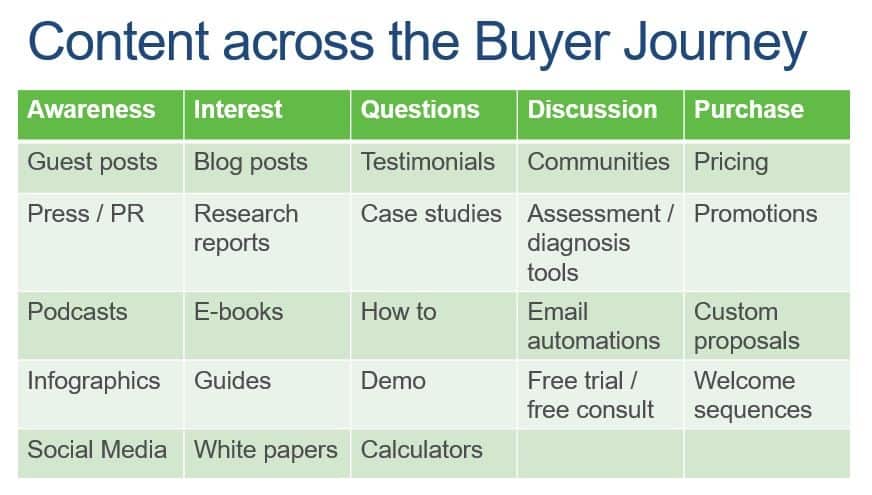
This is useful to see what content you should have, or might need to create. But it doesn’t answer the next obvious questions.
- Is your content effective?
- Is it cost-effective?
That’s where KPIs come in. You might know you have great awareness, but you’re not closing any business. Why not? Where are you losing people? Customer journey KPIs can help you work out where you need to improve.
Non-financial KPIs show how good your content is at moving people along the customer journey. Financial KPIs show how much it costs per person who moves to the next stage. Both are useful.
Let’s start at the very beginning. A very good place to start. 😉
KPIs for the Awareness stage of the customer journey
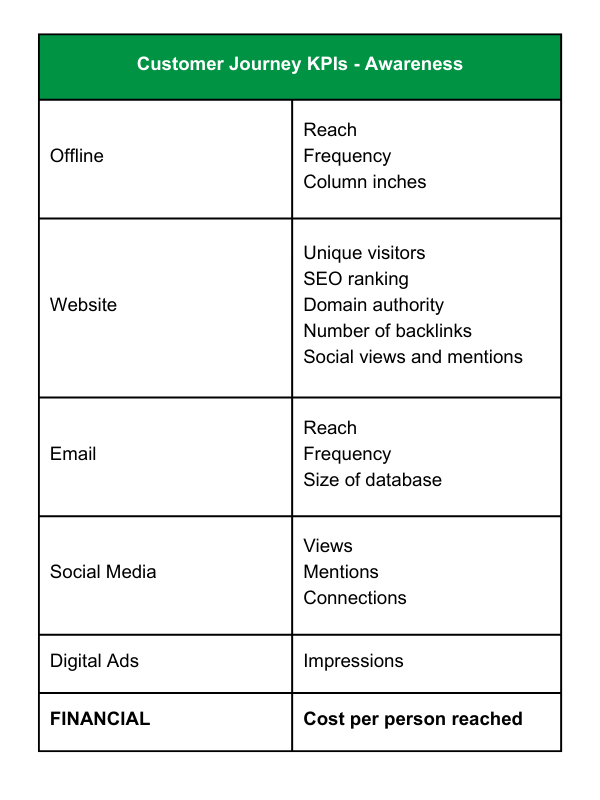
Awareness is the very first step on the customer journey.
Have your potential customers ever heard of you? Do they know what you do?
There’s no point in being your industry’s ‘best kept secret’. Start by building profile. There are plenty of ways you can do that:
- Online advertising (Google, social media platforms, websites serving your client market)
- SEO
- Social media
- Offline advertising (print, direct mail, outdoor)
- Email to third party lists
- Publicity (both online and offline)
With so many options, there are also many different measures of ‘success’. Some of these overlap, which makes things confusing. Even worse, online and offline may use different terminology for the same thing.
There’s a comprehensive diagram further down this post, but the key question we’re trying to answer is quite simple.
How many people even know your business exists?
In marketing campaign, this usually translates to ‘How many people have seen your content?’ There are three main measures for this.
- For traditional print media, we use reach and frequency. (Newspapers and magazines may use circulation instead of reach.)
- For online content, it’s unique impressions.
- And for email (third party email to other lists, to grow your awareness), it’s the number of opens.
Note, there is some fuzziness in all these measures.
- The circulation of a magazine is not exactly the same for every issue. Nor do you know how many people read a particular copy.
- If someone looks at your content on a laptop, then later looks at it on mobile, is that one unique impression or two? The answer may vary depending on whether the user is logged in or not, or on the system used to track results.
- Email open rates are affected by inbox settings. Different email systems have different default settings. Users adjust those defaults. It’s complicated, but if you really want to know more, this post is a good place to start.
This fuzziness is unavoidable, especially at the start of the customer journey. Accept it and move one. Remember, even if you could count the number of people who see your content accurately, you still wouldn’t know whether they liked it, or how much.
Additional Awareness KPIs
There are plenty more KPIS you can use to assess awareness.
- Column inches was once popular for publicity. It measured the space a publication dedicated to your business.
But it’s not all that useful. A column inch in the Australian Financial Review is (probably, depending on your business) worth more than a column inch in the Wentworth Courier. And how do you compare TV or radio coverage, let alone online mentions? - On social media, you can track views. Mentions and connection requests also show that someone out there knows you exist.
- Companies like Moz and Ahrefs rank websites by domain authority. This won’t tell you how many people have seen your website, but it does give an indication of your overall standing compared to competitors.
- SEO ranking is also a way to assess your profile for specific topics or keywords.
How do you choose your KPIs?
You want some idea what’s going on, but you don’t want to get bogged down measuring every little thing.
Start by working out what your main marketing channels are. Then pick 3-5 measures which apply to those channels. Then measure. Track over time. The main goal with awareness is to have increasing awareness over time.
Measuring Engagement or Interest
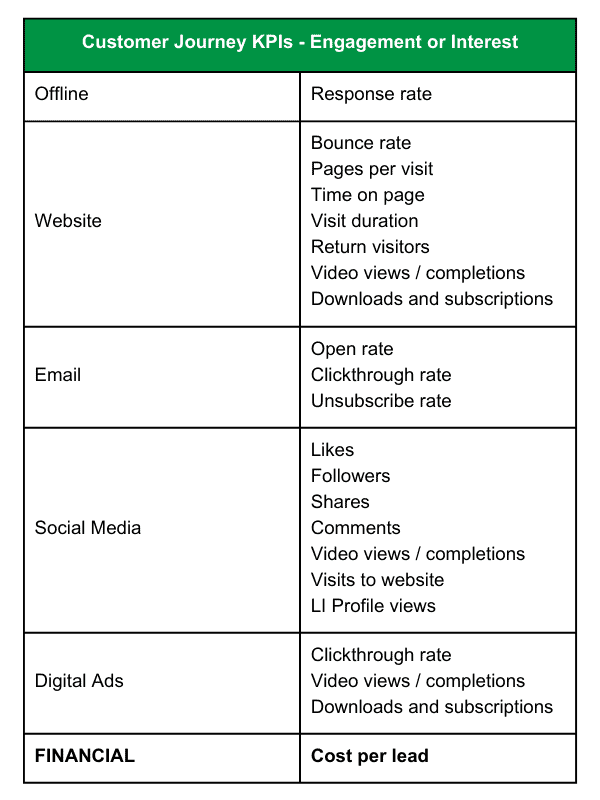
Interest is the next step along the customer journey. It’s important. People start wondering what you do. Paying attention. Interacting.
Because they interact in all kinds of different ways, there are still plenty of KPI options at this stage of the customer journey – especially online.
Website engagement
On your website, you can look at the bounce rate – do people stay? You can also measure whether they visit more than once; how long they stay on the site; the number of pages they visit; whether they watch videos and so on. You can even track visits to specific pages which show high interest – that might be a service page, or a pricing page.
An important metric is how well your website converts. A conversion is basically any interaction which means you have the user’s contact details, and permission to use them. This could be a newsletter sign-up, the download of a useful resource, an enquiry, an appointment booking or (for e-commerce) a purchase.
Subscriptions and downloads are low commitment conversions. You have permission to contact these people, but they’re not yet interacting real time on a one-on-one basis.
Other conversions – for example an enquiry (by phone, email or form) or an appointment booking – are a sign that the person or business is ready to discuss some details. They’re moving from interest to the questions / negotiation stage.
It makes sense to have both options on your website, since people progress at different speeds.
Social media
Social media is diverse and complex.
The simplest engagements require almost no effort from the user. It’s easy to like a post, or follow your account.
Other activities suggest more engagement. Sharing your content is great because it increases reach and implicitly endorses you. Comments, especially ones which go beyond ‘Well done’ or ‘Interesting’ to add to the discussion, are a real sign of engagement. On LinkedIn, people clicking from your content to your main profile shows interest in you and your business as well as what you posted, so it’s worth tracking profile views. Connection requests (from potential clients rather than people selling to you) are a great measures.
You may also want to track how much traffic is coming to your website from social media. Once again, this implies people are interested in more than just your post. Alternatively, you might want to measure private messages on the social platform itself.
Email and digital advertising
The primary measure of engagement is the click-through rate – the percentage of individuals seeing an ad or receiving an email who click on a link. This means they’ve been interested enough to find out more.
Of course, you usually also want them to do something after they click through. All the website engagement metrics apply.
Offline
Offline advertising is much simpler. People receive direct mail or view your ad. They either respond, or they don’t.
The ones who respond have probably moved beyond interest to questions and negotiation – unless you’re running a prize draw with the purpose of collecting contact details for future marketing.
KPIS for the Consideration stage of the Customer Journey
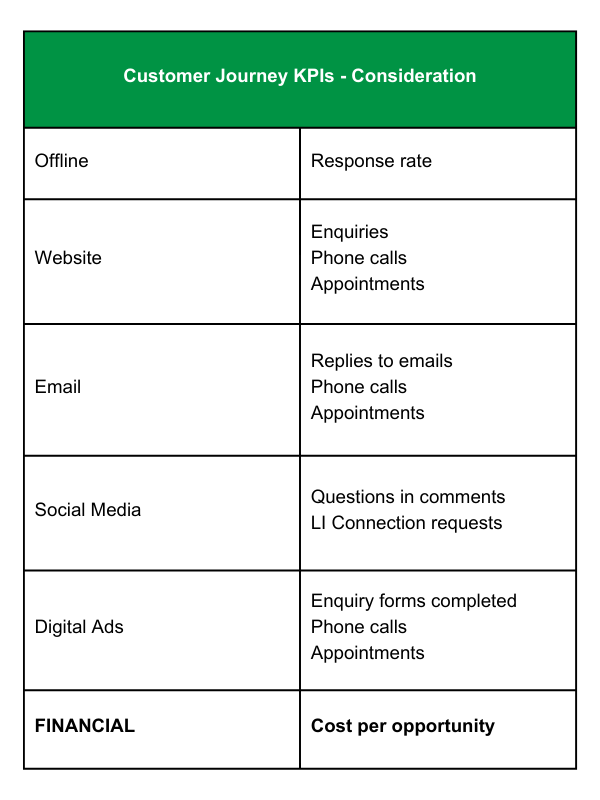
As should be clear by now, the border between ‘interest’ and ‘consideration’ is somewhat blurred. But at some point, potential clients start thinking seriously about your product or service and how it suits their needs. They have specific questions. Depending on what you offer, they may need to provide information so that you can quote. The conversation shifts from generalities to specifics. (It also becomes more of a conversation rather than you shouting from the rooftops hoping they’re listening!)
This is when ‘leads’ become ‘prospects’ or ‘opportunities’.
At this point in the customer journey, KPIs converge. They depend more on how you do business than the specific marketing channel.
Enquiries. Phone calls. Appointments. Requests for quotations or proposals. We’re moving from marketing to sales.
Decision and Purchase
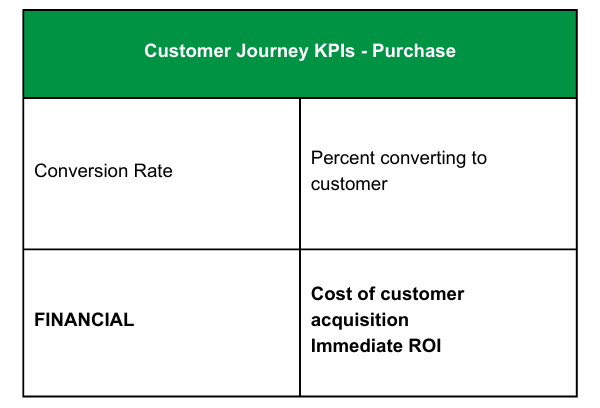
Crunch time! What percentage of your opportunities convert to customers?
That was simple, wasn’t it? 😊
But let’s not stop there. Getting a customer is only the start. You also want to keep that customer.
KPIs for Loyalty and Retention
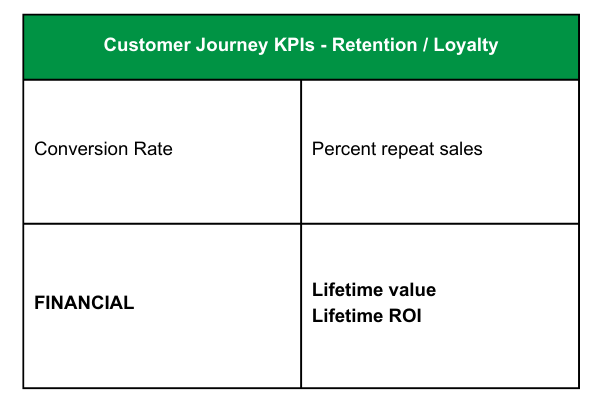
Selling more to existing customers is nearly always easier than selling the first thing to a new customer. So it makes sense to measure how well you upsell, cross-sell and repeat sell!
- What percent of your revenue comes from repeat business?
- How many purchases does the average customer make?
- What’s the customer’s life time value? That’s the amount they spend with you from their first purchase all the way to their last.
This is also a good place to mention customer satisfaction. It doesn’t pay bills, but it does give you an early indication of whether customers are likely to come back for more.
The final stage of the customer journey: Advocacy
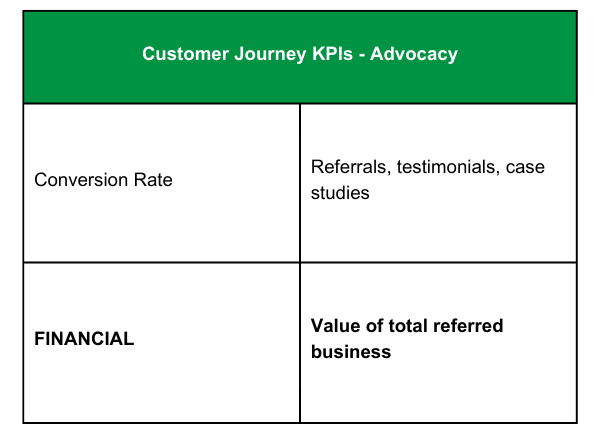
Advocacy is last but by no means least. Who doesn’t love raving fans?
Existing or past clients who sing your praises are fantastic. They bring you more business. They are especially important if your business is one with little or no opportunity for repeat sales. Custom built homes. Solar panel installation. Divorce. Funeral services.
How much of your business comes from client referrals? That’s a great measure for this stage of the journey.
You can also track customer reviews, testimonials and case studies. If you get positive reviews, if clients are happy to contribute to case studies, then you have advocates.
Financial KPIs
Only one of the KPIs listed above is financially based – the life time value of a customer.
But the majority of them can easily be converted to a financial measure.
Not the number of impressions, but the cost per impression. Not the reach, but the cost per person reached. Not the number of enquiries, but the cost per enquiry.
Financial KPIs can be useful for comparing different marketing channels. They can also be misleading. You may be reaching more people, but the wrong people. You may get more enquiries, but not quality ones which convert to customers.
The following table shows three (imaginary) campaigns, via three different marketing channels.
You can see that if you look at the financial KPIs, different campaigns perform best at different stages of the customer journey. That’s because the percentage of people moving on to the next stage changes from one campaign to the next.
So what’s the purpose of these interim KPIs? Simply, they help you know where things are going wrong. Where you’re losing potential clients. So you know where to look when you’re trying to make improvements.
That is, of course, what measurement is all about. As Peter Drucker famously said, ‘What gets measured gets managed.’ So pick some customer journey KPIs, measure them, and work on ways to bring more customers along the journey from awareness to customer, and eventually to advocate!

